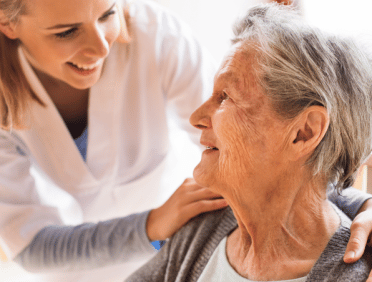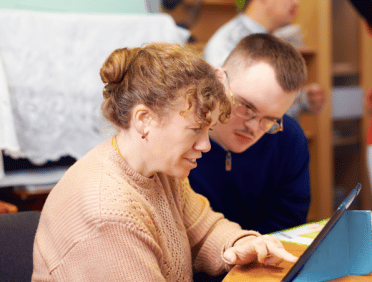What is the definition of “safeguarding” in the context of at-risk vulnerable adults in the UK?
Safeguarding is the process, procedures, policies and activities that ensure that adults who are classed as being vulnerable are at less risk from harm, ill-treatment, neglect or abuse. It not only helps to ensure that vulnerable adults are not harmed by someone else who knows what they are doing is wrong, but also those who have become victims of abuse or neglect from someone who simply is not aware that what they are doing and the way that they are acting is causing harm to the vulnerable adult.
Who holds the responsibility for safeguarding vulnerable adults at risk in the UK?
It is the responsibility of everyone who works with, around or takes care of the person who is vulnerable to be aware of safeguarding and how they can ensure that the person is safe. However, the over-arching responsibility lies with the Local Authority that covers the area that the vulnerable person lives in.
They are in charge of overseeing the processes, the procedures and of course ensuring that all of the relevant agencies communicate fully to ensure that those who are most vulnerable are protected.
What categories of risk do vulnerable adults face within the scope of safeguarding?
- Adults who are identified as being vulnerable are among some of the most common to require safeguarding help. This means that they are at risk of abuse and neglect, more so when you compare this to those who are not identified as being vulnerable.Some of the areas of abuse that these adults are most at risk of include:
- Physical abuse
- Sexual abuse
- Psychological abuse
- Modern Slavery
- Neglect
- Financial or material abuse
- Self-neglect
- Discriminatory abuse
- Domestic violence
- Organisational abuse
All of these, if they are suspected should be investigated fully to ensure that they are not the case and that the vulnerable person is safe from harm.
How can one identify signs of potential abuse or neglect in vulnerable adults at risk?
There are a number of signs that could indicate that a vulnerable adult is at risk of being harmed or abused. Of course, these can vary between people and really depends on what they are normally like.
Some of the main signs that someone is at risk of harm, or who is currently a victim include:
- Living in conditions that are not sanitary
- Poor personal hygiene and an appearance that is unkempt
- A lack of things that they need for everyday life, including food and clothing
- Dehydration or malnutrition
- Neglecting the maintenance of the house they live in
- Hoarding both things and animals
- Being withdrawn
- Physical signs, such as burns or bruises
What steps should be taken if there are concerns regarding the safety of a vulnerable adult at risk?
If you are concerned about the safety of an adult who has been identified as being vulnerable then you should ensure that you follow the safeguarding process that relates to your situation. If you work within care, this may be the policy that is set out by your employer.
However, if you are someone who is not working with the adult, but instead has a concern about them, then you should speak to your Local Authority to raise this. They can then investigate your concerns further and make sure that they are able to offer the help that is required to the individual and keep them as safe as possible.
What legal frameworks and policies exist to protect vulnerable adults at risk from abuse in the UK?
One of the main legal frameworks that is there to protect vulnerable adults in the UK is the Care Act 2014. This set out how Local Authorities and other key parts of the system are responsible for ensuring that adults who are most at risk of both abuse and neglect are protected as much as they can be.
How do local authorities and relevant agencies collaborate in the process of safeguarding vulnerable adults at risk?
It is important that every agency that is involved in the care and well-being of a vulnerable adult is involved in the safeguarding process. The reason for this is that each agency may have its own piece of information that relates to the adult and be able to fit all of those things together to make a larger picture.
Without this collaborative approach to working, there is always a chance that some vital signs of the person not being treated in a way that is appropriate are missed, which means that they could not gain access to the help that they need.
How does the process of safeguarding vulnerable adults at risk differ from that of safeguarding children?
No matter why the person is identified as being vulnerable, it is important to recognise that as an adult, vulnerable adults have the right to self-determination. This means that they can make the decision whether or not they want to act in a way that protects themselves.
Whilst this may sound like it is going to be counter-productive, it is this self-determination that can mean that the process of safeguarding that adult (and having the law involved) is different to those that apply to children.
What support services are available for vulnerable adults at risk who have experienced abuse or neglect?
If someone who is identified as being a vulnerable adult is at risk of harm, or who has been a victim of neglect and abuse, then they will be able to access a variety of support services to help them deal with the feelings that they may have.
This could be directly through the social care services that their Local Authority provides, or it could be via a charity or organisation who are there to help them. Some examples of this are Respond, Scope and Mind. Amongst many others.
How can individuals report suspicions of abuse or neglect of vulnerable adults at risk while maintaining anonymity?
If you are an individual and you believe that a vulnerable adult is at risk of abuse or neglect, then the first thing that you should do is contact your relevant Local Authority to discuss with them your concerns.
It is important to know that you can do this, whilst still being able to maintain your anonymity. However, you may be asked to provide your relevant contact details to allow the Local Authority to get back in touch with you for any further information and to discuss what you think may be happening. However, this information will not be shared with anyone else.
What measures can communities and individuals take to mitigate risks and ensure the well-being of vulnerable adults at risk?
Whilst the responsibility for keeping vulnerable adults safe falls to the Local Authority, the community and individuals within it also have a key part to play. They are there to ensure that those who are most at risk of harm are protected.
Communities are there all the time, they see things on a daily basis, so, as long as they have involvement with the person, they are going to be able to to notice when something is not quite right.
Not only this, but they can also encourage the person to support and safeguard themselves. They can offer them support and guidance, they can ensure that they have someone to talk to when they feel that they need to share.
What training opportunities exist for those interested in understanding more about safeguarding vulnerable adults at risk?
The majority of training is going to be available to be on offer to those who work in care and who work with those who are vulnerable. However, this doesn’t mean that you cannot access training if you do not work in these areas.
There is lots of information online that you can then use to help you learn more about abuse and neglect and what you can do to help mitigate it and offer support to the person who is at risk.
What are the legal implications for individuals found guilty of abusing or neglecting vulnerable adults in the UK?
As with many crimes, if you are found guilty of abusing or neglecting someone who is identified as being a vulnerable adult, then you are going to have to face legal implications. The nature of the implication will really depend on the crime that was committed and its severity.
This could be a fine, or it could be a time in prison.
How does the Mental Capacity Act influence the safeguarding of vulnerable adults at risk?
The Mental Capacity Act 2005 is there to ensure that vulnerable adults are protected. Every adult in the UK has the right to make their own decision, where they can and if they are unable to do this alone, they should have access to trusted adults to help them to make the decision that is best for them.
That said, if they are seen to not have the right level of mental capacity, then they may not be able to make a decision, even if that decision relates to their own safety and well-being.
How does the concept of dignity and respect factor into the safeguarding process for vulnerable adults at risk?
Every adult has the right to be treated in a way that is dignified and that shows respect to them as a human. They should feel that they are safe and they should also feel empowered in any choices that they may make for themselves. This also includes any decisions that relate to their care and support.
How do healthcare professionals contribute to the identification and prevention of abuse or neglect of vulnerable adults at risk?
Healthcare professionals form one of the agencies that need to be able to collaboratively work with other agencies in safeguarding. This means that they are responsible for playing a part in the safeguarding of vulnerable adults.
Even those who are working with them on an individual basis. They can notice changes in the person, even those which are subtle, and they can then share this with others in the multi-agency group.
Sometimes this means that they have the last puzzle piece to help to identify what may be happening to the adult and then be able to help them to stay safe.
How are the participation and preferences of the vulnerable adults at risk incorporated into the safeguarding process?
Even adults who have been identified as being vulnerable have the right to be involved with and make decisions that impact their own lives. This means that if there is a safeguarding concern, then this should be discussed with the adult and their thoughts and preferences asked for.
This means that they feel that they are in charge or play an active role in their own care and they can make requests. Though, of course, if there is a real risk of harm, they may need to be guided in the right direction,
How does the approach to safeguarding differ for vulnerable adults at risk with disabilities or mental health concerns?
Even adults who have mental health concerns or disabilities have the right to make their own decisions. This is something that applies to all adults. However, the law can intervene if it is thought that the adult is not going to be able to make a decision that is going to place them in even more harm.
What are the major challenges in providing effective safeguarding for vulnerable adults at risk in the UK?
It can be difficult to ensure that adults who are vulnerable are effectively safeguarded. Especially since the very nature of their being vulnerable means that they are likely to be at risk of harm, abuse or neglect.
Some of the key factors that can impact the safeguarding of an adult who is vulnerable:
- Social isolation
- Inadequate care and self-care
- Lack of awareness from the person who requires care
- Lack of awareness from the people who are caring
- Exploitation by those around the adult
- Not wanting to get involved when someone has a concern of being abused or neglected
How can communities and individuals contribute to establishing a secure environment for vulnerable adults at risk in their localities?
When it comes to safeguarding an adult who is vulnerable, it is important that every single person around them takes charge of this. Even those who are in the wider community. Those who are around the adult can make sure that the adult is monitored and that any changes that could point towards abuse are noted.
They can also ensure that the person themselves feels supported and safe. They can think about what decisions they make that they relate to themselves and their care and be able to talk through what their own concerns are and what this can mean for them.
Safeguarding Training
- Learn Q’s Safeguarding Children Level 1 is an introductory course that provides a basic understanding of safeguarding vulnerable children. It covers the concept of safeguarding, the importance of safeguarding, the legislation in place to protect vulnerable children, the signs of abuse and how to avoid them, and how to respond when a vulnerable child discloses they are being abused or neglected. This course is suitable for anyone who works with vulnerable children, including managers, supervisors, employees, and volunteers at all levels.
- Learn Q’s Safeguarding Children Level 2 course, on the other hand, is a more advanced course that builds on the knowledge gained in Level 1. It provides a more in-depth understanding of safeguarding, including recognising abuse, the responsibilities of different safeguarding roles, effective communication, and how to handle concerns and incidents related to safeguarding. This course is designed for those with additional safeguarding responsibilities, such as those who work in hospitals, general practices, nursing homes, care homes, or domiciliary care, as well as in religious organisations and community organisations.
- The Safeguarding Adults Level 1 course (£25) offered by Learn Q in the UK covers several key areas crucial for the protection of vulnerable adults. Participants will learn about the concept of safeguarding vulnerable adults, the importance of safeguarding, relevant legislation, recognising signs of abuse, responding to disclosures of abuse or neglect, and reporting safeguarding concerns while maintaining confidentiality.
- The Safeguarding Adults Level 2 course (£28) at Learn Q is designed for individuals with additional safeguarding responsibilities, particularly those working in settings like hospitals, general practices, nursing homes, care homes, domiciliary care, religious organisations, and community organisations. It is ideal for seasoned team members who have already completed introductory Level 1 training. The course content includes understanding the concept of safeguarding vulnerable adults, the importance of safeguarding, relevant legislation, signs of abuse, responding to abuse or neglect disclosures, reporting safeguarding concerns, maintaining confidentiality, understanding workplace safeguarding roles and responsibilities, multi-agency working, and effective communication skills
- Learn Q’s Preventing Radicalisation course is designed to help frontline sectors to be aware of how to prevent radicalism and extremism. Especially for individuals who have contact with adults who may be vulnerable. It raises awareness of the signs and techniques of radicalisation so that you can provide support and guidance to individuals in need as well as save their lives if you can identify these signs.
You can get further savings by purchasing one of Learn Qs money saving bundles, such as:
These courses are ideal for those who work in hospitals, general practices, nursing homes, care homes, domiciliary care, as well as in religious and community organisations. By completing this course, you will be better equipped to handle safeguarding concerns and to ensure the safety and well-being of vulnerable adults.
At Learn Q, we are committed to providing high-quality training that meets the needs of professionals across a range of industries. Our Safeguarding Children courses are designed to provide you with the knowledge and skills you need to excel in your role and make a real difference in the lives of vulnerable children. Sign up today and take the next step in your career!












